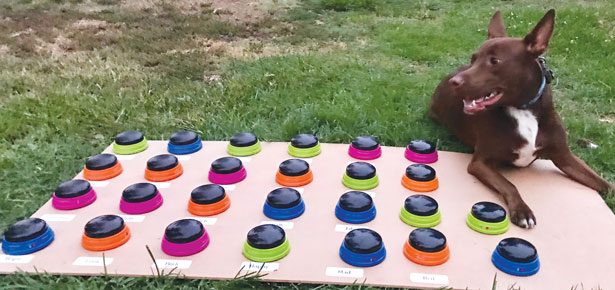

Smarty Paws: Living with a Canine Einstein
Signs you have a smart dog on your hands, and how to challenge your clever pup
Have you ever met a dog so smart it was a little scary? Many years ago, I was vacuuming under my dining room table when a flash of pink caught the corner of my eye. Tucked behind one of the table legs was a sticky pyramid of stacked Benadryl tablets. I had been giving the pills to my Shetland Sheepdog, Merlin, for an allergy issue. He had apparently been depositing his medication out of sight for about a week, in a neat little hot pink pile. No wonder his allergies weren’t getting any better!
I knew I was in trouble early on, when Merlin climbed over a baby gate at eight weeks of age. He was one of the smartest dogs I have ever known. Throughout his life, he challenged me to stay a step ahead of him.
……………………………………………………………………………………………………
The Top 10 Smartest Dog Breeds
These breeds top the canine intelligence charts, according to Dr. Stanley Coren, author of The Intelligence of Dogs. These bright breeds tend to learn a new command in less than five exposures and obey at least 95 percent of the time.
1. Border Collie
2. Poodle
3. German Shepherd
4. Golden Retriever
5. Doberman Pinscher
6. Shetland Sheepdog
7. Labrador Retriever
8. Papillon
9. Rottweiler
10. Australian Cattle Dog
……………………………………………………………………………………………………
Scientists debate levels of intelligence in animals all the time. In her wonderful book, Alex and Me, Dr. Irene Pepperberg describes a 30-year journey with her African Grey parrot, Alex, proving he was more than a “bird brain.” Every time she would demonstrate that Alex could think and solve problems, scientists would lay another challenge in her path. She and Alex knocked down many barriers. Dr. Pepperberg proved that a bird could add, was capable of thought and intention, and understood concepts like bigger, smaller, and none.
One of the challenges in defining intelligence in animals is that we use human standards to craft the definition. If you apply a human’s perspective to this definition, can it really apply to different species? What’s smart for a chimpanzee versus smart for a panda? Without common languages, it’s also hard to measure intelligence in other species. Do our tests actually assess a dolphin’s intelligence, or does the dolphin really think the tests are silly and indulges us out of amusement?
For now, let’s keep it simple. “Intelligence” is defined as the ability to acquire and apply knowledge and skills. Using this definition, you’ve surely known dogs who were brilliant, and some who couldn’t find their way out of an open exercise pen. Here are some indicators you may have a smart pup on your hands.
Illustration by Michelle Simpson
1. He has a good memory.
Your dog chased a squirrel up a specific tree in the park and every time he goes past that tree, he checks to see if the squirrel is still there. Ok, so your dog doesn’t understand that squirrel could be in a different county by now, but he remembers the same tree.
2. He learns new things quickly.
It doesn’t take him many repetitions to learn new behaviours. For example, you taught him to shake his paw in minutes, and he understood housetraining fast.
3. He is a problem solver.
Some people say that dogs can’t solve problems. I’ve never understood this, because I’ve witnessed dogs problem-solving too many times: the dog who figures out how to get the giant stick through the small gate opening; the dog who learns how to push furniture up against the counter so he can jump up and get crackers out of the cabinet; the escape artist who figures out how to unlock his kennel door.
When Merlin wanted a bone that was in the possession of my other Sheltie, Sundance, he would stare at her intently for a few minutes. Then, he would rush to the front door and bark furiously. She quickly abandoned the bone and ran to join him, barking at the door. As soon as she got there, Merlin would dash back and steal her bone. Problem solved! Sundance fell for this every time, so she might be an example of a dog that wasn’t as intellectually gifted as her brother.
Whether you call this manipulation or problem solving, it’s clever. It requires thought process to achieve a goal.
……………………………………………………………………………………………………
The Slow Learner
Are you worried that your dog may not be smart? Before you point fingers, make sure you’re being a good teacher. Sometimes, the problem isn’t the student!
Are you teaching the meaning of cues?
Just saying “Fido, Come!” doesn’t mean your dog knows what that is. Saying, “Sit! Sit! Sit!” a hundred times doesn’t teach your dog to sit. You need to first show him what the words mean.
Are you consistent with your cues?
If you say, “Get down!” to tell your dog to get off the counter and “Down” to tell your dog to lie down, how does he know which “Down” you mean? Do you say “Sit” but your partner says, “Sit Down”? Do you tell your dog to “Come” to walk with you, and then get mad when he doesn’t run to you from across the yard when you call him with “Come!”? One cue can’t have multiple meanings. It’s too confusing for a dog.
Do you have realistic expectations?
You’ve trained your dog to come to you when he’s in the backyard. You take him to the dog park, and he acts like he’s never heard the word before. Is he stubborn? Is he stupid? Neither. You haven’t completed his training. Your backyard does not have the distractions of a dog park. You skipped ahead to an advanced behaviour without building a solid foundation.
If you’re having trouble training your dog, consult a reward-based trainer who uses the science of learning to get your canine student on track. A good trainer will also be training you!
……………………………………………………………………………………………………
I’m Bored!
Smart dogs can be a joy to train. If you are not up to training your dog, however, you might be in for a rocky ride. Smart dogs get bored easily, and they’re going to find ways to amuse themselves. It’s far better if YOU help them make those choices. Otherwise, you might see behavioural issues you don’t like, such as destructive chewing, vocalization (whining, barking, or howling), fence fighting (running up and down a fence line obsessively) or digging. If you have a smart dog, it’s important that you not only exercise his body, but also exercise his brain.
How to Challenge Your Smart Dog.
Here are some ideas on how to keep your brilliant pup on his toes.
Make him work for his meals. Inhaling a bowl of food is no challenge. Feed his meals out of food-dispensing puzzle toys. It will slow his consumption down and he’ll need to figure out how to access the food for a fun brain teaser.
Train him! Teach him good family manners, such as Sit, Down, Place, Wait, and Heel.
Teach him tricks. Start with simple behaviours, such as Spin or Roll Over. Gradually work up to advanced behaviours, such as directed retrievals or putting his toys away in a box.
Teach him to follow his nose with scent work. You can do this for fun or get competitive and earn titles.
Try a dog sport, such as Rally or Agility. It’s something you two can learn together.
There were definitely times when I got frustrated at my Merlin’s intelligence, especially the day he learned to escape double gates and open a door blocking him from the kitchen. He then jumped up on a chair to gain access to a freshly baked cake cooling on the table. I had only been gone minutes but returned to a cake that had nibble marks all around the edges. Merlin’s brain kept me on my toes, but life with him was never boring.
Join the newsletter and never miss out on dog content again!
"*" indicates required fields
By clicking the arrow, you agree to our web Terms of Use and Privacy & Cookie Policy. Easy unsubscribe links are provided in every email.






